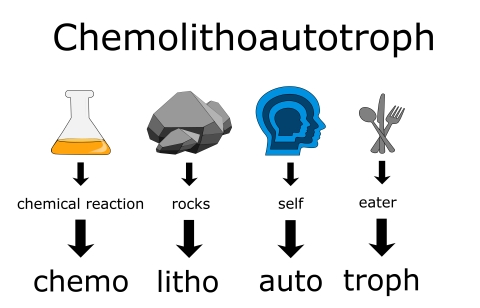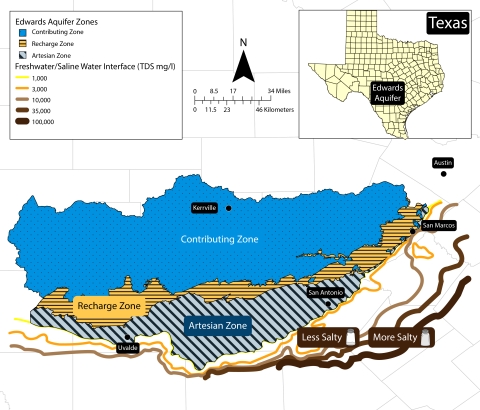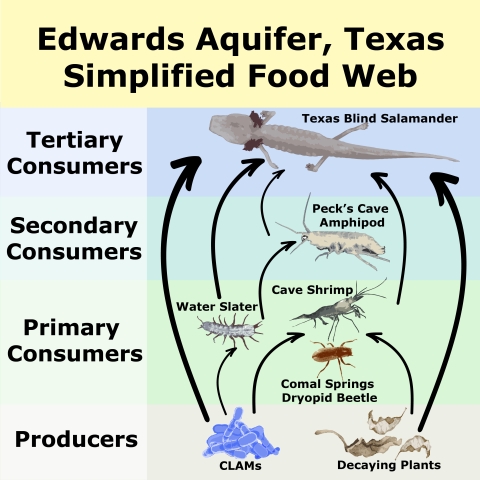“Life found within the Edwards Aquifer can be very alien-like,” said Amelia Hunter, Fish and Wildlife Biologist with the Southwest Regional Office. “Many of these species lack eyes and pigment. When they eat, you can see the contents in their guts. These creatures are creepy crawly and fascinating.”
As part of Hunter’s job, she uses the best available scientific and commercial data to better understand how to support the conservation of organisms within the Edwards Aquifer through drafting recovery-related documents. During her research, she began to appreciate the complexities of the food web as well as the importance of the unique mixing of freshwater and saline water within the aquifer. The freshwater-saline water boundary allows very tiny organisms to create food, supporting a rich variety of life.
Low-Key High Energy
Tiny microbes found within the Edwards Aquifer help make it one of the most ecologically diverse aquifers in the world. These microbes, known as chemolithoautotrophs, may have a complex name, but their metabolic process is relatively simple. Instead of obtaining energy from the sun through photosynthesis like plants, these microorganisms extract energy from inorganic chemicals such as ammonia, sulfur or hydrogen. The microorganisms sometimes exist in extreme environments such as deep-sea hydrothermal vents and the geothermal hot springs found throughout Yellowstone National Park. These habitats host a variety of tiny organisms, as does the Edwards Aquifer in Central Texas.
Their tiny metabolic process adds up to significant energy resources (food) for other living things. The biomass formation of chemolithoautotrophy communities is comparable to the production rates recorded in boreal forests!
The Fix is In
Chemolithoautotrophic microbes (CLAMs) are some of the most ancient organisms found and are crucial for life on the planet. Along with photosynthetic organisms such as plants, CLAMs are primary producers that transform nonliving elements into life-supporting ingredients. They help build the bedrock of life, or more accurately, they unbuild bedrocks by turning rocks into usable sustenance. For instance, CLAMs living in root nodules of “nitrogen-fixing” plants transform nitrogen in the soil into readily available ammonia compounds. Plants then use the ammonia compounds for growth, transforming them into the building blocks of life such as amino acids and proteins. Within the Edwards Aquifer, CLAMs are a significant food source for stygobionts, another name for subterranean aquatic animals.
Edwards Aquifer: A Landscape of Rock Sponges
The Edwards Aquifer is a significant source of drinking water for Central Texas, one of the fastest growing areas in the United States. People, plants and animals depend on freshwater for survival. The honeycombed, water-filledEdwards Aquifer provides freshwater to over 2.5 million people. It is part of a karst landscape, or a landform that contain caves, springs, sinkholes and sinking streams. Karst landscapes form within soluble rocks such as limestone or dolomite. Over time, groundwater erodes away at the rocks, creating cavities and caves. Groundwater can collect in the interconnected matrix of cracks and holes found within karst landscapes.
“Unlike a forest or a mountain, this ecosystem is hard to fathom,” said Hunter. “When I think about describing it, I first imagine its geologic structure structure
Something temporarily or permanently constructed, built, or placed; and constructed of natural or manufactured parts including, but not limited to, a building, shed, cabin, porch, bridge, walkway, stair steps, sign, landing, platform, dock, rack, fence, telecommunication device, antennae, fish cleaning table, satellite dish/mount, or well head.
Learn more about structure . The aquifer is karst, meaning water over time has carved holes through the limestone. Some of the holes are so large they are caverns with interconnected tunnels. Other areas have very tiny spaces filled like a water-soaked sponge. It is a very dark place with a consistent temperature in its deeper portion. The limestone acts as a natural insulator.”
In the Zone
The Edwards Aquifer can be categorized based on its water context. This simplified explanation separates the Edwards Aquifer zones or areas which include the: contributing zone, recharge zone, artesian zone and the freshwater-saline water interface zone.
The contributing zone is where runoff from precipitation drains into the aquifer. The recharge zone is located where water adds to the aquifer. The artesian zone describes the area in the aquifer where water is confined and under pressure. The freshwater-saline water interface zone describes where freshwater and water with a higher concentration of salt meet.
Researchers conclude that the origin of the saline water zone is multifaceted, involving dissolution of rocks. Overtime, this has created high mineral and salinity concentrations due to the presence of evaporite minerals.The freshwater-saline water boundary has been mapped multiple times since 1956 with adjustments being made because of refined mapping techniques- not because of increased salinization of fresh water.
Freshwater is considered saline once it reaches about 1,000 parts per million (ppm) of dissolved salts- mostly sodium chloride. The freshwater-saline water boundary found in the Edwards Aquifer has a salinity that varies from 1,000 ppm to 100,000 ppm. For reference, ocean water has an average saline concentration of about 35,000 ppm.
Although you wouldn’t want to drink the saline water in the Edwards Aquifer, this freshwater-saline water interface zone is incredibly important for many of the species reliant upon the aquifer. CLAMs make the Edwards Aquifer an incredibly diverse place and within this brackish, “bad water” zone is where life gets interesting.
The Underwater Underdogs
Karst aquifers typically have limited amounts of food available. This is because life within this underground habitat is usually dependent upon surface food including plants, microbial communities in surface streams and seasonal precipitation. For the Edwards Aquifer, food arrives from the surface and derives from CLAMs found within the freshwater-saline water interface. Over a long period of time (think thousands and thousands of years), CLAMs provide consistent meals to other stygobionts, and contribute to making the Edwards Aquifer one of the most diverse stygobiontic communities on the planet.
CLAMs are a dependable cuisine for other stygobionts. This is especially important during times of low groundwater levels and decreases in plant-derived snacks. CLAMs add to the food web’s complexity which creates more species interactions and supports diversification of species. Eleven threatened or endangered species live within the Edwards Aquifer - many of which are found nowhere else. And there are still more new species to be described!
Texas blind salamanders eat a variety of food including crustaceans and insects which in turn eat tiny CLAMs. They are not picky eaters, and the way they eat can be entertaining according to Hunter. “When I worked at the San Marcos Aquatic Resources Center, sometimes I got to feed the Texas blind salamanders,” said Hunter. “Although they have non-functioning eyes, they would move and wiggle their heads, sensing the incoming worms. When they would eat, they would use their acute senses to detect their prey and seize the food with their pointed teeth. Like how fish use their lateral line to detect movements in water, Texas blind salamanders rely on their specialized sensory cells and acute senses of chemoreception and touch to hunt and capture prey. They use their pointed teeth to seize small invertebrates. Occasionally, we would place live amphipods in their tanks. The older salamanders proved to be better hunters than the younger ones, which would have the critters crawling all over them.”
Support Your Local Groundwater
“Aside from enthusiastically exploring the critters found in karst groundwater, one of my other roles as a biologist with the Service is to highlight how we protect species,” said Hunter. I am passionate about empowering others to help with conservation by providing information about the Endangered Species Act listing and recovery processes. In addition, partners and researchers can get involved by attending the Texas Groundwater Invertebrate Forum. The fall of 2024 will be the sixth year that we will gather to discuss research, data needs, the future of conservation of the life found in Texas groundwater.”
In the United States, karsts make up about 20 percent of the landscape and about 40 percent of groundwater drinking water comes from karst aquifers. Karsts are fragile ecosystems with threats and stressors such as climate change climate change
Climate change includes both global warming driven by human-induced emissions of greenhouse gases and the resulting large-scale shifts in weather patterns. Though there have been previous periods of climatic change, since the mid-20th century humans have had an unprecedented impact on Earth's climate system and caused change on a global scale.
Learn more about climate change that can impact the ecology and water supply through more frequent and severe droughts. Urban development places increasing demands on groundwater. In addition, the interconnected nature of karst aquifers makes them especially vulnerable to contamination because polluted water can be transported rapidly with little filtration.
All of us can help protect groundwater. Practice water conservation by reducing water use, planting native species and reconsidering impervious cover to allow precipitation to drain into the aquifer. In addition, learn more about your local groundwater. Do you know where your drinking water comes from and the critters that call it home?
Additional Information
The food web diagram is based on research from Ecology’s 2016 journal article, “Chemolithoautotrophy supports macroinvertebrate food webs and affects diversity and stability in groundwater communities,”by Benjamin Hutchins, Annette Summers Engel, Weston Nowlin, and Benjamin Schwartz. The article can be found online at doi.org/10.1890/15-1129.1.







